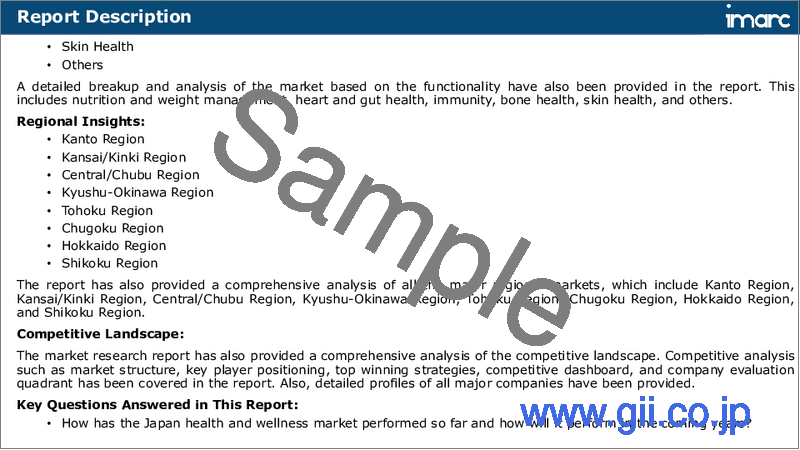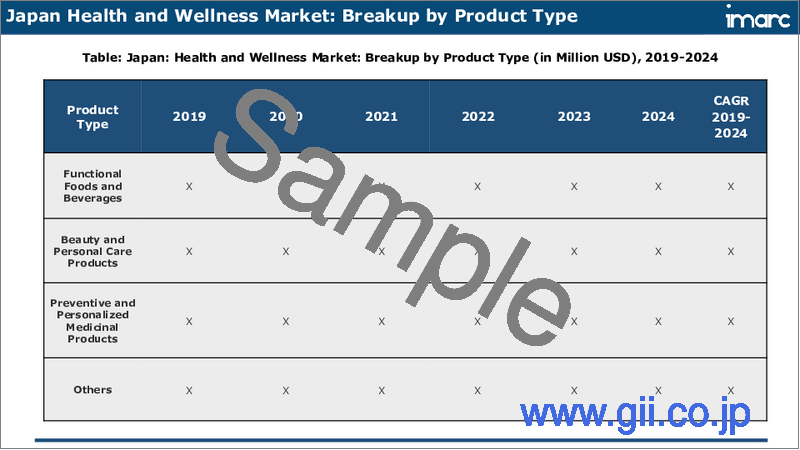|
|
市場調査レポート
商品コード
1729370
日本のヘルスおよびウェルネス市場レポート:製品タイプ、機能、地域別、2025年~2033年Japan Health and Wellness Market Report by Product Type, Functionality, and Region 2025-2033 |
||||||
カスタマイズ可能
|
|||||||
| 日本のヘルスおよびウェルネス市場レポート:製品タイプ、機能、地域別、2025年~2033年 |
|
出版日: 2025年05月01日
発行: IMARC
ページ情報: 英文 121 Pages
納期: 5~7営業日
|
全表示
- 概要
- 目次
日本のヘルスおよびウェルネス市場規模は2024年に2,072億8,000万米ドルに達しました。今後、IMARC Groupは、同市場が2033年までに2,875億米ドルに達し、2025~2033年の成長率(CAGR)は3.51%になると予測しています。個人の健康と福祉に対する意識の高まりと優先順位付け、ヘルスケア技術、遠隔医療、遠隔モニタリングソリューションにおける技術革新の高まり、加齢に伴う健康上の懸念に対応する専門的な製品とサービスに対する需要の高まりが、市場を牽引する主な要因のいくつかです。
本レポートで扱う主な質問
- 日本のヘルスおよびウェルネス市場はこれまでどのように推移し、今後どのように推移するのか?
- COVID-19が日本のヘルスおよびウェルネス市場に与えた影響は?
- 日本のヘルスおよびウェルネス市場の製品タイプ別区分は?
- 日本のヘルスおよびウェルネス市場の機能別区分は?
- 日本のヘルスおよびウェルネス市場のバリューチェーンにおける様々なステージとは?
- 日本のヘルスおよびウェルネスの主な促進要因と課題は?
- 日本のヘルスおよびウェルネス市場の構造と主要プレーヤーは?
- 日本のヘルスおよびウェルネス市場における競合の程度は?
目次
第1章 序文
第2章 調査範囲と調査手法
- 調査の目的
- ステークホルダー
- データソース
- 市場推定
- 調査手法
第3章 エグゼクティブサマリー
第4章 日本のヘルスおよびウェルネス市場:イントロダクション
- 概要
- 市場力学
- 業界動向
- 競合情報
第5章 日本のヘルスおよびウェルネス市場情勢
- 過去および現在の市場動向(2019~2024年)
- 市場予測(2025~2033年)
第6章 日本のヘルスおよびウェルネス市場:製品タイプ別の内訳
- 機能性食品・飲料
- 美容およびパーソナルケア製品
- 予防および個別化医薬品
- その他
第7章 日本のヘルスおよびウェルネス市場:機能別の内訳
- 栄養と体重管理
- 心臓と腸の健康
- 免疫
- 骨の健康
- 肌の健康
- その他
第8章 日本のヘルスおよびウェルネス市場:競合情勢
- 概要
- 市場構造
- 市場企業のポジショニング
- 主要成功戦略
- 競合ダッシュボード
- 企業評価象限
第9章 主要企業のプロファイル
第10章 日本のヘルスおよびウェルネス市場:業界分析
- 促進要因、抑制要因、機会
- ポーターのファイブフォース分析
- バリューチェーン分析
第11章 付録
Japan health and wellness market size reached USD 207.28 Billion in 2024. Looking forward, IMARC Group expects the market to reach USD 287.50 Billion by 2033, exhibiting a growth rate (CAGR) of 3.51% during 2025-2033. The growing awareness and prioritization of personal health and well-being, rising innovations in healthcare technology, telemedicine, and remote monitoring solutions, and increasing demand for specialized products and services that cater to age-related health concerns represent some of the key factors driving the market.
Health and wellness refer to a state of complete physical, mental, and social well-being, where an individual is not merely free from illness or disease but also thriving in various aspects of their life. They comprise physical wellness, which involves activities like regular exercise, a balanced diet, adequate sleep, and maintaining a healthy weight. They also consist of mental wellness, which includes stress management techniques, cognitive-behavioral therapy, meditation, and mindfulness to enhance mental resilience. They encompass social and emotional wellness, which facilitates the building and nurturing of relationships, engaging in social activities, and seeking support when needed all contribute to social wellness. They encourage individuals to practice meditation and prayer or connect with nature to find inner peace and purpose. They lead to a higher quality of life, with increased energy, vitality, and resilience. They enable the prevention of various chronic diseases and conditions, reducing healthcare costs and personal suffering. They can help prevent and alleviate mental health issues, such as depression and anxiety. They help to develop emotional intelligence and coping strategies for greater emotional resilience in the face of challenges in life. They can provide a sense of purpose, peace, and fulfillment. They can speed up healing, improve quality of life, and reduce the risk of relapse.
Japan Health and Wellness Market Trends:
At present, the increasing awareness and prioritization of personal health and well-being, compelling individuals to adopt healthier lifestyles, focusing on physical fitness, mental well-being, and balanced nutrition, represents one of the crucial factors impelling the market growth in Japan. Besides this, the rising innovations in healthcare technology, telemedicine, and remote monitoring solutions are contributing to the market growth in the country. In addition, the growing importance of immune health, hygiene, and overall wellness is leading to a rise in demand for immune-boosting supplements, personal protective equipment, and health-focused digital platforms. Apart from this, the increasing demand for specialized products and services that cater to age-related health concerns, including chronic diseases, mobility issues, and cognitive health, is supporting the market growth. Additionally, people are turning to practices like yoga, acupuncture, and meditation for mental and emotional well-being alongside traditional medicine. This shift towards holistic wellness is catalyzing the demand for complementary and alternative medicines, as well as natural and organic products. Moreover, key market players are adopting sustainable practices and promoting ethical and socially responsible initiatives to meet the evolving demands of sustainable, plant-based, and ethically sourced health and wellness products. Furthermore, the implementation of strict regulations associated with health and wellness offerings is encouraging companies to provide evidence-based claims for their health and wellness products.
Japan Health and Wellness Market Segmentation:
Product Type Insights:
- Functional Foods and Beverages
- Beauty and Personal Care Products
- Preventive and Personalized Medicinal Products
- Others
Functionality Insights:
- Nutrition and Weight Management
- Heart and Gut Health
- Immunity
- Bone Health
- Skin Health
- Others
Competitive Landscape:
The market research report has also provided a comprehensive analysis of the competitive landscape. Competitive analysis such as market structure, key player positioning, top winning strategies, competitive dashboard, and company evaluation quadrant has been covered in the report. Also, detailed profiles of all major companies have been provided.
Key Questions Answered in This Report:
- How has the Japan health and wellness market performed so far and how will it perform in the coming years?
- What has been the impact of COVID-19 on the Japan health and wellness market?
- What is the breakup of the Japan health and wellness market on the basis of product type?
- What is the breakup of the Japan health and wellness market on the basis of functionality?
- What are the various stages in the value chain of the Japan health and wellness market?
- What are the key driving factors and challenges in the Japan health and wellness?
- What is the structure of the Japan health and wellness market and who are the key players?
- What is the degree of competition in the Japan health and wellness market?
Table of Contents
1 Preface
2 Scope and Methodology
- 2.1 Objectives of the Study
- 2.2 Stakeholders
- 2.3 Data Sources
- 2.3.1 Primary Sources
- 2.3.2 Secondary Sources
- 2.4 Market Estimation
- 2.4.1 Bottom-Up Approach
- 2.4.2 Top-Down Approach
- 2.5 Forecasting Methodology
3 Executive Summary
4 Japan Health and Wellness Market - Introduction
- 4.1 Overview
- 4.2 Market Dynamics
- 4.3 Industry Trends
- 4.4 Competitive Intelligence
5 Japan Health and Wellness Market Landscape
- 5.1 Historical and Current Market Trends (2019-2024)
- 5.2 Market Forecast (2025-2033)
6 Japan Health and Wellness Market - Breakup by Product Type
- 6.1 Functional Foods and Beverages
- 6.1.1 Overview
- 6.1.2 Historical and Current Market Trends (2019-2024)
- 6.1.3 Market Forecast (2025-2033)
- 6.2 Beauty and Personal Care Products
- 6.2.1 Overview
- 6.2.2 Historical and Current Market Trends (2019-2024)
- 6.2.3 Market Forecast (2025-2033)
- 6.3 Preventive and Personalized Medicinal Products
- 6.3.1 Overview
- 6.3.2 Historical and Current Market Trends (2019-2024)
- 6.3.3 Market Forecast (2025-2033)
- 6.4 Others
- 6.4.1 Historical and Current Market Trends (2019-2024)
- 6.4.2 Market Forecast (2025-2033)
7 Japan Health and Wellness Market - Breakup by Functionality
- 7.1 Nutrition and Weight Management
- 7.1.1 Overview
- 7.1.2 Historical and Current Market Trends (2019-2024)
- 7.1.3 Market Forecast (2025-2033)
- 7.2 Heart and Gut Health
- 7.2.1 Overview
- 7.2.2 Historical and Current Market Trends (2019-2024)
- 7.2.3 Market Forecast (2025-2033)
- 7.3 Immunity
- 7.3.1 Overview
- 7.3.2 Historical and Current Market Trends (2019-2024)
- 7.3.3 Market Forecast (2025-2033)
- 7.4 Bone Health
- 7.4.1 Overview
- 7.4.2 Historical and Current Market Trends (2019-2024)
- 7.4.3 Market Forecast (2025-2033)
- 7.5 Skin Health
- 7.5.1 Overview
- 7.5.2 Historical and Current Market Trends (2019-2024)
- 7.5.3 Market Forecast (2025-2033)
- 7.6 Others
- 7.6.1 Historical and Current Market Trends (2019-2024)
- 7.6.2 Market Forecast (2025-2033)
8 Japan Health and Wellness Market - Competitive Landscape
- 8.1 Overview
- 8.2 Market Structure
- 8.3 Market Player Positioning
- 8.4 Top Winning Strategies
- 8.5 Competitive Dashboard
- 8.6 Company Evaluation Quadrant
9 Profiles of Key Players
- 9.1 Company A
- 9.1.1 Business Overview
- 9.1.2 Product Portfolio
- 9.1.3 Business Strategies
- 9.1.4 SWOT Analysis
- 9.1.5 Major News and Events
- 9.2 Company B
- 9.2.1 Business Overview
- 9.2.2 Product Portfolio
- 9.2.3 Business Strategies
- 9.2.4 SWOT Analysis
- 9.2.5 Major News and Events
- 9.3 Company C
- 9.3.1 Business Overview
- 9.3.2 Product Portfolio
- 9.3.3 Business Strategies
- 9.3.4 SWOT Analysis
- 9.3.5 Major News and Events
- 9.4 Company D
- 9.4.1 Business Overview
- 9.4.2 Product Portfolio
- 9.4.3 Business Strategies
- 9.4.4 SWOT Analysis
- 9.4.5 Major News and Events
- 9.5 Company E
- 9.5.1 Business Overview
- 9.5.2 Product Portfolio
- 9.5.3 Business Strategies
- 9.5.4 SWOT Analysis
- 9.5.5 Major News and Events
10 Japan Health and Wellness Market - Industry Analysis
- 10.1 Drivers, Restraints and Opportunities
- 10.1.1 Overview
- 10.1.2 Drivers
- 10.1.3 Restraints
- 10.1.4 Opportunities
- 10.2 Porters Five Forces Analysis
- 10.2.1 Overview
- 10.2.2 Bargaining Power of Buyers
- 10.2.3 Bargaining Power of Suppliers
- 10.2.4 Degree of Competition
- 10.2.5 Threat of New Entrants
- 10.2.6 Threat of Substitutes
- 10.3 Value Chain Analysis





